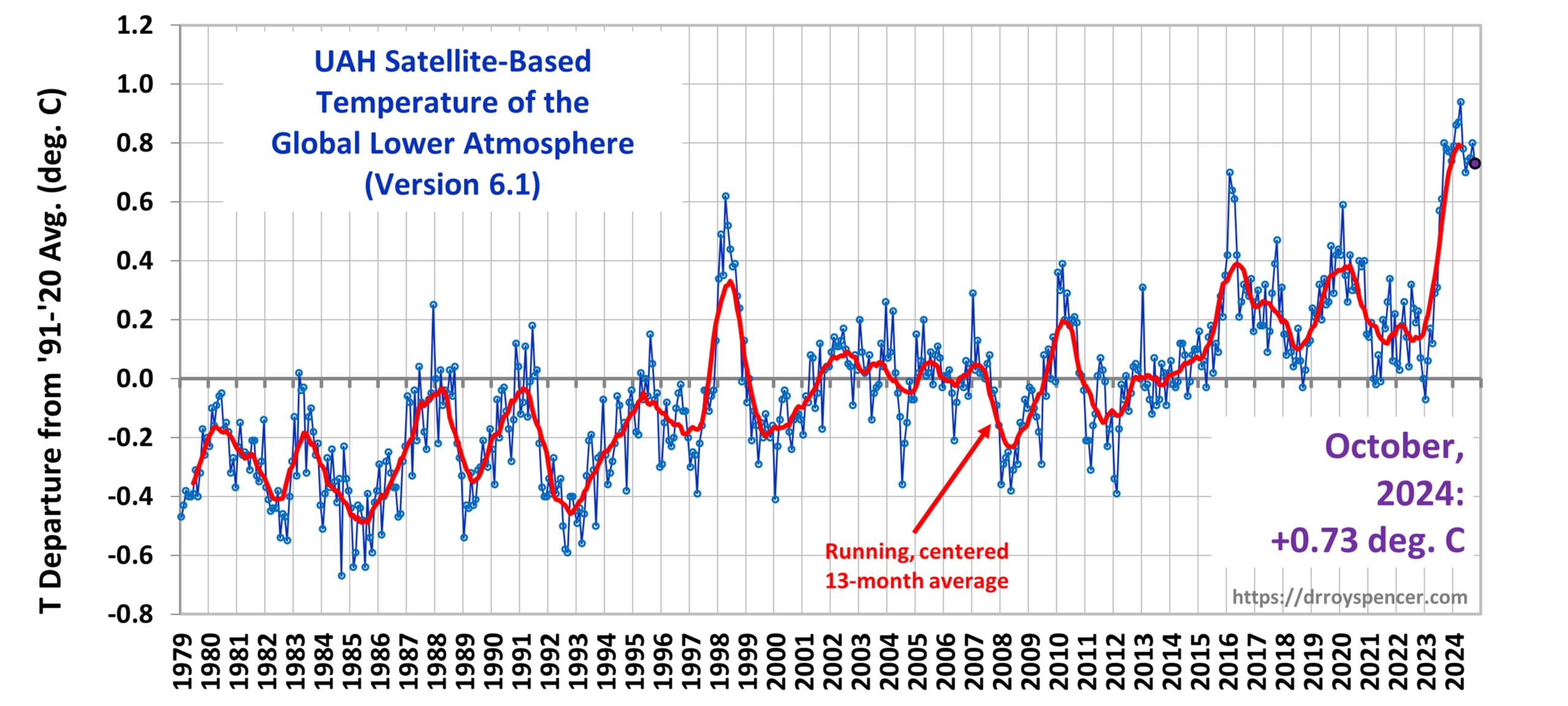From one of the two keepers of the satellite temperature record, the University of Alabama - Huntsville's Dr. Roy Spencer, November 2:
UAH v6.1 Global Temperature Update for October, 2024: +0.73 deg. C After Truncation of the NOAA-19 Satellite Record
The Version 6.1 global average lower tropospheric temperature (LT) anomaly for October, 2024 was +0.73 deg. C departure from the 1991-2020 mean, down from the September, 2024 anomaly of +0.80 deg. C.

The new (Version 6.1) global area-averaged temperature trend (January 1979 through October 2024) is now +0.15 deg/ C/decade (+0.21 C/decade over land, +0.13 C/decade over oceans).
The previous (version 6.0) trends through September 2024 were +0.16 C/decade (global), +0.21 C/decade (land) and +0.14 C/decade (ocean).
The following provides background for the change leading to the new version (v6.1) of the UAH dataset.
NOTE: Snide comments which suggest someone has not read (and understood) that which follows will lead to comment privileges being revoked.
Key Points
- The older NOAA-19 satellite has now drifted too far through the diurnal cycle for our drift correction methodology to provide useful adjustments. Therefore, we have decided to truncate the NOAA-19 data processing starting in 2021. This leaves Metop-B as the only satellite in the UAH dataset since that date. This truncation is consistent with those made to previous satellites after orbital drift began to impact temperature measurements.
- This change reduces recent record global warmth only a little, bringing our calculated global temperatures more in line with the RSS and NOAA satellite datasets over the last 2-3 years.
- Despite the reduction in recent temperatures, the 1979-2024 trend is reduced by only 0.01 deg/ C/decade, from +0.16 C/decade to +0.15 C per decade. Recent warmth during 2023-2024 remains record-setting for the satellite era, with each month since October 2023 setting a record for that calendar month.
Background
Monitoring of global atmospheric deep-layer temperatures with satellite microwave radiometers (systems originally designed for daily global weather monitoring) has always required corrections and adjustments to the calibrated data to enable long-term trend detection. The most important of these corrections/adjustments are:
- Satellite calibration biases, requiring intercalibration between successively launched satellites during overlaps in operational coverage. These adjustments are typically tenths of a degree C.
- Drift of the orbits from their nominal sun-synchronous observation times, requiring empirical corrections from comparison of a drifting satellite to a non-drifting satellite (the UAH method), or from climate models (the Remote Sensing Systems [RSS] method, which I believe the NOAA dataset also uses). These corrections can reach 1 deg. C or more for the lower tropospheric (LT) temperature product, especially over land and during the summer.
- Correction for instrument body temperature effects on the calibrated temperature (an issue with only the older MSU instruments, which produced spurious warming).
- Orbital altitude decay adjustment for the multi-view angle version of the lower tropospheric (LT) product (no longer needed for the UAH dataset as of V6.0, which uses multiple channels instead of multiple angles from a single channel.)
The second of these adjustments (diurnal drift) is the subject of the change made going from from UAH v6.0 to v6.1. The following chart shows the equator crossing times (local solar time) for the various satellites making up the satellite temperature record. The drift of the satellites (except the non-drifting Aqua and MetOp satellites, which have fuel onboard to allow orbit maintenance) produces cooling for the afternoon satellites’ LT measurements as the afternoon observation transitions from early afternoon to evening. Drift of the morning satellites makes their LT temperatures warm as their evening observations transition to the late afternoon....
....MUCH MORE